How Take-Out Containers Evolved To Meet Consumer Needs
The history of take-out containers is a story of innovation driven by consumer needs and societal changes. From the early days of simple food wraps to the sophisticated containers we use today, this journey reflects changing lifestyles, environmental awareness, and technological advancements. Read on for a comprehensive exploration of how take-out containers evolved to meet consumer needs.
The Early Years: Simple Beginnings
In the early 20th century, take-out food was a novel concept, and the containers used were rudimentary. Simple paper wraps and basic boxes, primarily designed to hold food briefly, were the norm. These containers reflected the times—functional but limited in their ability to preserve food quality or offer any substantial protection during transportation.
The Post-War Boom: Rise of Convenience
Post World War II, the booming economy and the rise of fast-food culture led to a surge in the demand for convenient food packaging. This era saw the introduction of more durable and protective materials like plastic and Styrofoam. These materials allowed for better food preservation and catered to the growing trend of on-the-go eating, marking a significant shift in the design and function of take-out containers.
The Age of Plastic: A New Standard
Plastic quickly became the standard material for take-out containers due to its versatility, durability, and low cost. Manufacturers could mold plastic containers into various shapes and sizes, catering to different types of food. However, this reliance on plastic also brought about environmental concerns, which eventually led to a push for more sustainable practices in the industry.
Innovation in Design: Enhancing Functionality
As consumer preferences evolved, so did the design of take-out containers. Innovations included containers with built-in compartments to separate different food items, improved sealing techniques to prevent leaks, and microwave and dishwasher-safe designs. These enhancements improved the functionality of the containers and enhanced the overall dining experience.
The Sustainability Movement: Eco-Friendly Alternatives
In response to growing environmental awareness, the industry began exploring eco-friendly alternatives to traditional plastic and Styrofoam containers. This led to the introduction of biodegradable materials, such as bagasse, bamboo, and cornstarch-based plastics. These materials decompose much faster than conventional plastics, offering a more sustainable solution to take-out packaging.
The Rise of Delivery Services: Adapting to a New Trend
The recent surge in food delivery services like Uber Eats and DoorDash has further influenced the evolution of take-out containers. Containers needed to be more durable and secure to withstand longer travel times and ensure food quality upon delivery. This led to innovations in sealing technology and the use of sturdier materials.
Branding and Customization: A Marketing Tool
Take-out containers have also become a powerful marketing tool for businesses. Customized containers with branded logos, colors, and designs increase brand recognition and enhance the customer experience. This trend has led to a rise in demand for unique and visually appealing container designs.
Consumer Health Awareness: Safety First
As health awareness increased, consumers became more concerned about the safety of the materials used in food packaging. This led to stricter regulations and the development of food-grade materials that were non-toxic and free from harmful chemicals. Safety standards for take-out containers have become a top priority, ensuring they are as safe as they are convenient.
The Convenience Factor: Ease of Use
Convenience has always been a key factor in the design of take-out containers. Recent developments have focused on making containers easier to open, handle, and store. Features like foldable flaps, stackable designs, and easy-to-grip surfaces have made take-out containers more user-friendly, catering to the fast-paced lifestyle of consumers.
Technology Integration: Smart Packaging
The integration of technology into take-out containers is a relatively new development. Smart packaging, which includes QR codes and NFC tags, allows consumers to access information about their food, like ingredients, calorie count, and even heating instructions, directly from their containers. This tech-forward approach aligns with the growing demand for transparency and convenience in the food industry.
Addressing Portion Control: Size Variations
With an increased focus on health and diet, take-out containers have evolved to offer a variety of sizes. This allows consumers to choose portions that align with their dietary needs, reducing food waste and promoting healthier eating habits. The availability of different-sized containers has become crucial to catering to diverse consumer needs.
Multi-Use Containers: Beyond Single-Use
The trend toward sustainability has also led to the development of multi-use take-out containers. Consumers can reuse these containers several times, reducing the environmental impact of single-use packaging. They offer an eco-friendly alternative and cater to the growing segment of environmentally conscious consumers.
Thermal Properties: Keeping Food at Optimal Temperatures
Maintaining food temperature during transportation has been a significant challenge in the take-out industry. Recent advancements in container materials have focused on improving thermal properties to keep hot food hot and cold food cold. This innovation ensures that the food stays high-quality from the restaurant to the consumer’s doorstep.
The Future of Take-Out Containers: Emerging Trends
The future of take-out containers will likely change with the continued innovation in sustainability, technology, and consumer convenience. We can expect to see further advancements in eco-friendly materials, smart packaging, and designs that cater to the evolving needs of consumers and the environment.
Sourcing Wholesale To-Go Containers
For businesses looking to keep up with these trends, sourcing wholesale to-go containers is a smart strategy. It allows for cost-effective purchasing of the latest in container technology and design, whether it’s eco-friendly materials, smart features, or containers tailored for delivery services. Innovations might include containers made from advanced biodegradable composites or even edible packaging. Additionally, the integration of technology is likely to become more prevalent.
We might see smart containers that can communicate freshness, temperature, or even the nutritional content of the food within. There’s also potential for further personalization and customization in container design as brands look to stand out and enhance customer engagement. These emerging trends indicate a future where take-out containers are functional and an integral part of the dining experience, reflecting broader societal trends and values.
Now that you know how take-out containers evolved to meet consumer needs, we hope their dynamism and variability are clear. From their simple beginnings to becoming a sophisticated solution, take-out containers continue to be a pivotal part of our dining culture.

Recent Posts
-
Why Are Pizza Boxes Made From Corrugated Cardboard?
Pizza boxes are ubiquitous and specifically designed to deliver hot and delicious pizza in the best …May 2nd 2024 -
4 Greener Ideas To Make Your Bakery More Sustainable
Sustainability is not just a trend; it's a commitment to our planet and future generations. Adopting …Apr 23rd 2024 -
4 Different Ways Your Food Business Can Use PET Cups
Polyethylene terephthalate (PET) cups have become a staple in the food and beverage industry due to …Apr 18th 2024




